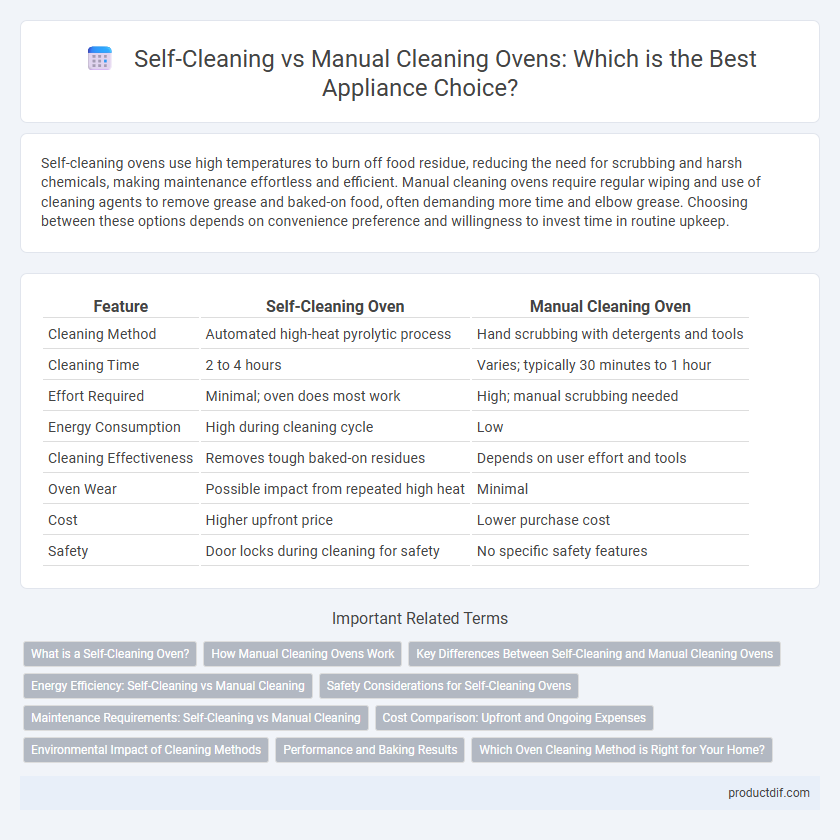Self-cleaning ovens use high temperatures to burn off food residue, reducing the need for scrubbing and harsh chemicals, making maintenance effortless and efficient. Manual cleaning ovens require regular wiping and use of cleaning agents to remove grease and baked-on food, often demanding more time and elbow grease. Choosing between these options depends on convenience preference and willingness to invest time in routine upkeep.
Table of Comparison
| Feature | Self-Cleaning Oven | Manual Cleaning Oven |
|---|---|---|
| Cleaning Method | Automated high-heat pyrolytic process | Hand scrubbing with detergents and tools |
| Cleaning Time | 2 to 4 hours | Varies; typically 30 minutes to 1 hour |
| Effort Required | Minimal; oven does most work | High; manual scrubbing needed |
| Energy Consumption | High during cleaning cycle | Low |
| Cleaning Effectiveness | Removes tough baked-on residues | Depends on user effort and tools |
| Oven Wear | Possible impact from repeated high heat | Minimal |
| Cost | Higher upfront price | Lower purchase cost |
| Safety | Door locks during cleaning for safety | No specific safety features |
What is a Self-Cleaning Oven?
A self-cleaning oven uses high temperatures, typically around 900degF (482degC), to burn off food residues and grease, reducing them to ash that can be easily wiped away. This pyrolytic process eliminates the need for harsh chemical cleaners and minimizes manual scrubbing. Self-cleaning ovens enhance convenience and maintain hygiene by simplifying the cleaning process compared to manual cleaning ovens.
How Manual Cleaning Ovens Work
Manual cleaning ovens require users to scrub and remove food residues and grease buildup inside the oven cavity using cleaning agents and tools such as sponges or scrubbing pads. Effective manual cleaning involves applying oven-specific cleaners, allowing them to penetrate baked-on grime, and then wiping or scraping the debris away. Unlike self-cleaning ovens that use high temperatures to burn off residues, manual cleaning demands regular maintenance to prevent stubborn stains and maintain optimal oven performance.
Key Differences Between Self-Cleaning and Manual Cleaning Ovens
Self-cleaning ovens utilize high temperatures, typically around 900degF, to incinerate food residues into ash, requiring less physical effort compared to manual cleaning methods. Manual cleaning ovens depend on scrubbing and chemical detergents to remove spills and stains, which can be labor-intensive and time-consuming. The self-cleaning feature reduces the risk of harsh chemical exposure and provides a more thorough internal cleaning, while manual cleaning offers greater control over delicate surfaces and sensitive parts.
Energy Efficiency: Self-Cleaning vs Manual Cleaning
Self-cleaning ovens utilize high-temperature heat cycles that consume significant energy, often ranging between 3 to 5 kWh per cleaning cycle, whereas manual cleaning requires minimal electricity but involves usage of chemical cleaners. Energy efficiency in self-cleaning ovens is dependent on the frequency of cleaning, with excessive cycles increasing overall energy consumption. Manual cleaning may conserve electricity but can involve environmental and health costs due to chemical usage, making the energy comparison complex beyond just electricity metrics.
Safety Considerations for Self-Cleaning Ovens
Self-cleaning ovens utilize high-temperature cycles reaching up to 900degF to burn off food residue, reducing the need for harsh chemical cleaners but posing burn risks if improperly handled. These ovens often feature locked doors during the cleaning process to prevent accidental burns, enhancing user safety compared to manual cleaning methods. It is essential to follow manufacturer guidelines carefully, as the intense heat can release smoke and odors that may affect indoor air quality without proper ventilation.
Maintenance Requirements: Self-Cleaning vs Manual Cleaning
Self-cleaning ovens feature a pyrolytic cleaning cycle that heats the interior to extreme temperatures, reducing food residues to ash and minimizing manual effort. Manual cleaning ovens require regular scrubbing with chemical cleaners and scrapers to remove grease and burnt-on food, increasing maintenance time and labor. Choosing a self-cleaning oven significantly lowers routine maintenance demands and chemical exposure compared to traditional manual cleaning methods.
Cost Comparison: Upfront and Ongoing Expenses
Self-cleaning ovens typically have a higher upfront cost, often ranging from $1,000 to $2,500, compared to manual cleaning ovens which can cost between $500 and $1,500. Ongoing expenses for self-cleaning models are lower due to reduced need for cleaning supplies and labor, while manual ovens require regular purchase of cleaning agents and more time investment. Energy consumption during the self-cleaning cycle may temporarily increase utility bills but overall maintenance costs tend to be less than those of manual cleaning ovens over time.
Environmental Impact of Cleaning Methods
Self-cleaning ovens utilize high temperatures to incinerate food residues, reducing the need for chemical cleaners and minimizing hazardous waste. Manual cleaning ovens often rely on harsh chemical agents which contribute to indoor air pollution and require water-intensive rinsing, increasing environmental strain. Choosing self-cleaning technology enhances energy efficiency and reduces the carbon footprint associated with routine oven maintenance.
Performance and Baking Results
Self-cleaning ovens utilize high-temperature pyrolytic cycles to effectively break down grease and food residue, maintaining consistent heat distribution and enhancing baking performance. Manual cleaning ovens may suffer from residue buildup that can cause uneven heating and negatively impact cooking results. The even temperature control in self-cleaning ovens ensures more precise baking outcomes with less maintenance effort.
Which Oven Cleaning Method is Right for Your Home?
Choosing between a self-cleaning oven and a manual cleaning oven depends on your lifestyle and cleaning preferences. Self-cleaning ovens use high heat to burn off food residues, reducing the effort and time spent on maintenance, while manual cleaning ovens require scrubbing with chemical cleaners, offering more control but demanding physical labor. Homeowners seeking convenience and efficiency often prefer self-cleaning ovens, whereas those concerned about energy use or chemical exposure might opt for manual cleaning methods.
Self-Cleaning Oven vs Manual Cleaning Oven Infographic

 productdif.com
productdif.com